Common menu bar links
Breadcrumb Trail
ARCHIVED - Status of Women Canada
 This page has been archived.
This page has been archived.
Archived Content
Information identified as archived on the Web is for reference, research or recordkeeping purposes. It has not been altered or updated after the date of archiving. Web pages that are archived on the Web are not subject to the Government of Canada Web Standards. As per the Communications Policy of the Government of Canada, you can request alternate formats on the "Contact Us" page.
Section III – Supplementary Information
Links to Government of Canada Outcomes
The following table shows the SWC program activities and their alignment with two of the Government of Canada outcomes:
- a diverse society that promotes linguistic duality and social inclusion, and
- income security and employment for Canadians.
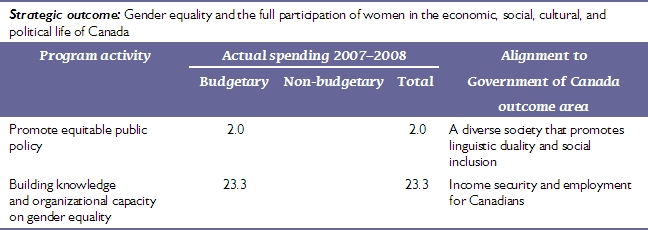
Table 1: Comparison of Planned to Actual Spending, including FTEs ($ millions)
The following table offers a comparison of SWC’s main estimates, planned spending, total authorities, and actual spending for 2007–2008, as well as historical figures for actual spending for 2005–2006 and 2006–2007, using the PAA. Resources may overlap in more than one program activity.
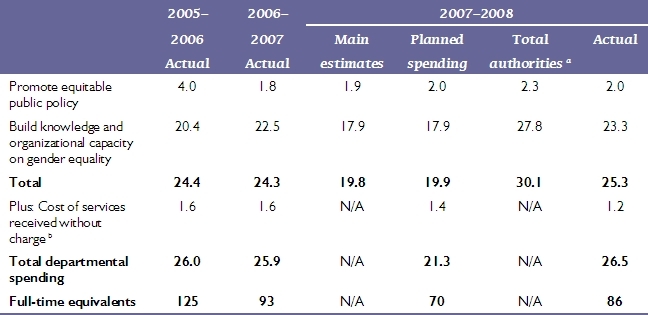
a In comparison with the planned spending, the total authorities include an increase of $0.6 million related to the 2006–2007 eligible operating budget carry forward, adjustments for collective agreements and pay list requirements of $0.4 million and additional operating and grants and contributions funding for a total net increase of $9.2 million.
b The $1.2 million in services received without charge during 2007–2008 include accommodation provided by PWGSC ($0.7 million), salary and associated expenditures for legal services provided by the Department of Justice ($0.1 million), contributions covering SWC’s share of employee’s insurance premiums and expenditures paid by Treasury Board Secretariat ($0.4 million).
Table 2: Voted and Statutory Items
The following table shows the Parliamentary votes that determine the resources allocated to SWC.
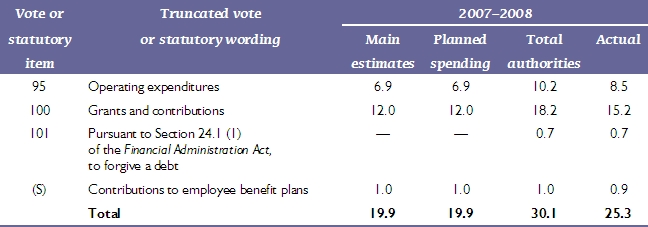
Table 3: User Fees
For supplementary information on the department’s user fees, please visit http://www.tbs-sct.gc.ca/dpr-rmr/st-ts-eng.asp.
Table 4: Policy on Service Standards for External Fees
The Policy on Service Standards for External Fees requires departments to report on the establishment of service standards for all external fees charged on a non-contractual basis. This policy covers fees charged for processing requests made under the Access to Information Act.
For supplementary information on the Department’s Service Standards for External Fees, please visit http://www.tbs-sct.gc.ca/dpr-rmr/st-ts-eng.asp.
Table 5: Details on Transfer Payment Programs for SWC ($18.2 million)
Further information on these programs can be found at http://www.tbs-sct.gc.ca/dpr-rmr/st-ts-eng.asp.
Table 6: Response to Parliamentary Committees
For supplementary information on the department’s response to Parliamentary Committees and External Audits please visit http://www.tbs-sct.gc.ca/dpr-rmr/st-ts-eng.asp.
Table 7: Internal Audits and Evaluations

Table 8: Travel Policies
For supplementary information on the department’s travel policies, please visit http://www.tbs-sct.gc.ca/dpr-rmr/st-ts-eng.asp.
Table 9: Financial Statements of Departments and Agencies (including Agents of Parliament) and Revolving Funds Financial Statements
Statement of Management Responsibility (Unaudited)
Responsibility for the integrity and objectivity of the accompanying financial statements for the year ended March 31, 2008 and all information contained in these statements rests with the management of Status of Women Canada. These financial statements have been prepared by management in accordance with Treasury Board accounting policies which are consistent with Canadian generally accepted accounting principles for the public sector.
Management is responsible for the integrity and objectivity of the information in these financial statements. Some of the information in the financial statements is based on management’s best estimates and judgment and gives due consideration to materiality. To fulfil its accounting and reporting responsibilities, management maintains a set of accounts that provides a centralized record of the Status of Women Canada’s financial transactions. Financial information submitted to the Public Accounts of Canada and included in the department’s Departmental Performance Report is consistent with these financial statements.
Management maintains a system of financial management and internal control designed to provide reasonable assurance that financial information is reliable, that assets are safeguarded and that transactions are in accordance with the Financial Administration Act, are executed in accordance with prescribed regulations, within Parliamentary authorities, and are properly recorded to maintain accountability of Government funds. Management also seeks to ensure the objectivity and integrity of data in its financial statements by careful selection, training and development of qualified staff, by organizational arrangements that provide appropriate divisions of responsibility, and by communication programs aimed at ensuring that regulations, policies, standards and managerial authorities are understood throughout the department.
The financial statements of the Status of Women Canada have not been audited.
Clare Beckton
Coordinator, Status of Women Canada
Johanne Tremblay
Senior Financial Officer
Date: July 16, 2008
Statement of Operations (Unaudited)

The accompanying notes form an integral part of these financial statements.
Statement of Financial Position (Unaudited)
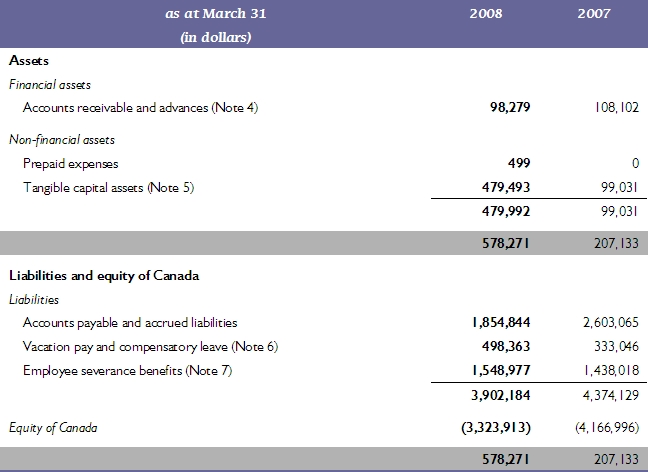
The accompanying notes form an integral part of these financial statements.
Statement of Equity (Unaudited)
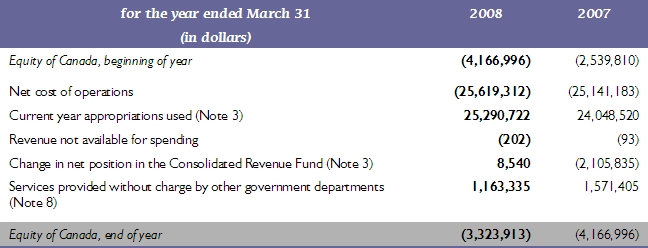
The accompanying notes form an integral part of these financial statements.
Statement of Cash Flow (Unaudited)
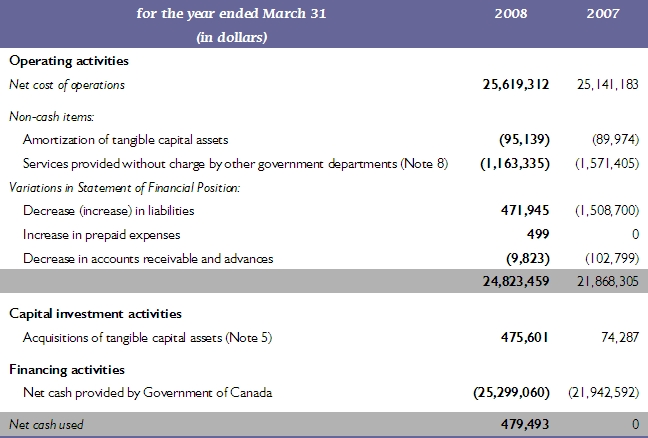
The accompanying notes form an integral part of these financial statements.
Notes to the Financial Statements (Unaudited)
1. Authority and Purpose
Status of Women Canada (SWC) was established by the Government of Canada in 1976 to “co- ordinate policy with respect to the status of women and administer related program” (Order in Council 1976-779). The mandate of SWC is further guided by the Canadian Charter of Rights and Freedoms, as well as by Canada’s adherence to the Convention on the Elimination of all Forms of Discrimination against Women and its renewed commitment to implement the United Nations’ Beijing Platform for Action (1995 and 2005). SWC plays a key role in fulfilling the Government of Canada’s commitment to building a society that is inclusive and respectful of all Canadians by promoting equitable public policy and building knowledge and organizational capacity on gender equality. We promote equality and the full participation of girls and women in Canada.
Strategic outcome: Gender equality and the full participation of women in the economic, social, cultural and political life of Canada. To achieve real progress on gender equality, SWC is firmly committed to consulting and acting in partnership with non-government organizations, provincial and territorial governments, the private sector, foreign governments and international organizations.
Program activities:
- Build knowledge and organizational capacity on gender equality: by focussing on developing the knowledge and capacity of a number of stakeholders so they are better informed and able to address gender- based issues of significance to Canadian society in a coordinated manner.
- Promote equitable public policy: by focussing on horizontal work across government and with other orders of government. Its goal is to influence the development of public policies and programs that respond to the diversity of women’s perspectives and realities.
2. Significant Accounting Policies
The financial statements have been prepared in accordance with Treasury Board accounting policies which are consistent with Canadian generally accepted accounting principles for the public sector.
Significant accounting policies are as follows:
(a) Parliamentary appropriations
The department is financed by the Government of Canada through Parliamentary appropriations. Appropriations provided to the department do not parallel financial reporting according to generally accepted accounting principles since appropriations are primarily based on cash flow requirements. Consequently, items recognized in the statement of operations and the statement of financial
position are not necessarily the same as those provided through appropriations from Parliament. Note 3 provides a high-level reconciliation between the bases of reporting.
(b) Net Cash Provided by Government
The department operates within the Consolidated Revenue Fund (CRF), which is administered by the Receiver General for Canada. All cash received by the department is deposited to the CRF and all cash disbursements made by the department are paid from the CRF. The net cash provided by Government is the difference between all cash receipts and all cash disbursements including
transactions between departments of the federal government.
(c) Change in net position in the Consolidated Revenue Fund
The change in net position in the Consolidated Revenue Fund is the difference between the net cash provided by Government and appropriations used in a year, excluding the amount of non-respendable revenue recorded by the department. It results from timing differences between when a transaction affects appropriations and when it is processed through the CRF.
(d) Revenues
Revenues are accounted for in the period in which the underlying transaction or event occurred that gave rise to the revenues.
(e) Expenses
Expenses are recorded on the accrual basis:
- Grants are recognized in the year in which the conditions for payment are met. In the case of grants which do not form part of an existing program, the expense is recognized when the Government announces a decision to make a non-recurring transfer, provided the enabling legislation or authorization for payment receives parliamentary approval prior to the completion of the financial statements.
- Contributions are recognized in the year in which the recipient has met the eligibility criteria or fulfilled the terms of a contractual transfer agreement.
- Vacation pay and compensatory leave are expensed as the benefits accrue to employees under their respective terms of employment.
- Services provided without charge by other government departments for accommodation, the employer’s contribution to the health and dental insurance plans and legal services are recorded as operating expenses at their estimated cost.
(f) Employee future benefits
i Pension benefits: Eligible employees participate in the Public Service Pension Plan, a multi-employer plan administered by the Government of Canada. The department’s contributions to the Plan are charged to expenses in the year incurred and represent the total obligation to the Plan. Current legislation does not require the
department to make contributions for any actuarial deficiencies of the Plan.
ii Severance benefits: Employees are entitled to severance benefits under labour contracts or conditions of employment. These benefits are accrued as employees render the services necessary to earn them. The obligation relating to the benefits earned by employees is calculated using information derived from the results of the actuarially determined liability for employee severance benefits for the Government as a whole.
(g) Accounts receivable
Accounts receivable are stated at amounts expected to be ultimately realized; a provision is made for receivables where recovery is considered uncertain.
(h) Tangible capital assets
All tangible capital assets and leasehold improvements having an initial cost of $2,500 or more are recorded at their acquisition cost. The department does not capitalize intangibles, works of art and historical treasures that have cultural, aesthetic or historical value, assets located on Indian Reserves and museum collections.
Amortization of capital assets is done on a straight-line basis over the estimated useful life of the capital asset as follows:

(i) Measurement uncertainty
The preparation of these financial statements in accordance with Treasury Board accounting policies, which are consistent with Canadian generally accepted accounting principles for the public sector, requires management to make estimates and assumptions that affect the reported amounts of assets, liabilities, revenues and expenses reported in the financial statements. At the time of
preparation of these statements, management believes the estimates and assumptions to be reasonable. The most significant items where estimates are used are the liability for employee severance benefits and the useful life of tangible capital assets. Actual results could significantly differ from those estimated. Management’s estimates are reviewed periodically and, as
adjustments become necessary, they are recorded in the financial statements in the year they become known.
3. Parliamentary Appropriations
The department receives most of its funding through annual Parliamentary appropriations. Items recognized in the statement of operations and the statement of financial position in one year may be funded through Parliamentary appropriations in prior, current or future years. Accordingly, the department has different net results of operations for the year on a government funding basis than on an accrual accounting basis. The differences are reconciled in the following tables:
(a) Reconciliation of net cost of operations to current year appropriations used:
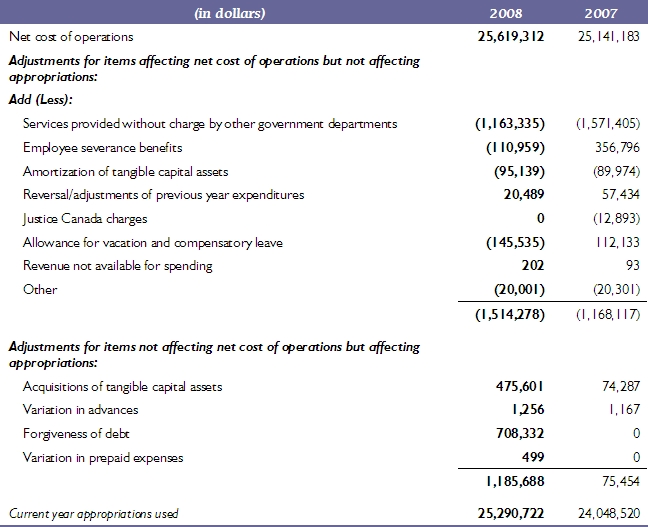
(b) Appropriations provided and used:
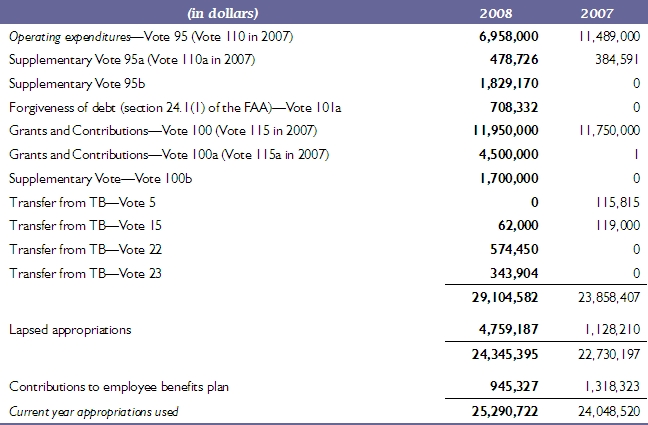
(c) Reconciliation of net cash provided by Government to current year appropriations used:

4. Accounts Receivable and Advances
The following table presents details of accounts receivable and advances:

a SWC has the approval and legal authority to make grants and contribution payments. As the spending authority applied to grants at the time the payment of $0.7 million was made, an accounting adjustment is required. Hence, an allowance for doubtful accounts of equivalent value was created.
5. Tangible Capital Assets

6. Vacation Pay and Compensatory Leave

7. Employee Benefits
(a) Pension benefits:
The department’s employees participate in the Public Service Pension Plan, which is sponsored and administered by the Government of Canada. Pension benefits accrue up to a maximum period of 35 years at a rate of 2 per cent per year of pensionable service, times the average of the best five consecutive years of earnings. The benefits are integrated with Canada/Québec Pension
Plans benefits and they are indexed to inflation.
Both the employees and the department contribute to the cost of the Plan. The 2007-08 expense amounts to $689,143 ($971,604 in 2006-07), which represents approximately 2.1 times (2.2 in 2006-07) the contributions by employees.
The department’s responsibility with regard to the Plan is limited to its contributions. Actuarial surpluses or deficiencies are recognized in the financial statements of the Government of Canada, as the Plan’s sponsor.
(b) Severance benefits:
The department provides severance benefits to its employees based on eligibility, years of service and final salary. These severance benefits are not pre-funded. Benefits will be paid from future appropriations. Information about the severance benefits, measured as at March 31, is as follows:

8. Related Party Transactions
The department is related as a result of common ownership to all Government of Canada departments, agencies, and Crown corporations. The department enters into transactions with these entities in the normal course of business and on normal trade terms. Also, during the year, the department received services which were obtained without charge from other Government departments as presented in part (a).
(a) Services provided without charge by other government departments:
During the year the department received without charge from other departments, accommodation, the employer’s contribution to the health and dental insurance plans, and legal services. These services without charge have been recognized in the department’s Statement of Operations as follows:

The Government has structured some of its administrative activities for efficiency and cost- effectiveness purposes so that one department performs these on behalf of all without charge. The costs of these services, which include payroll and cheque issuance services provided by Public Works and Government Services Canada and audit services provided by the Office of the Auditor General, are not included as an expense in the department’s Statement of Operations.
(b) Payables and receivables outstanding at year-end with related parties:

